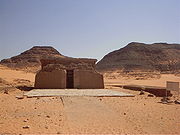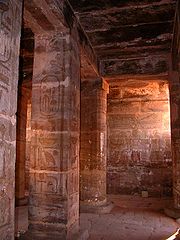
Amada
Encyclopedia


Egyptian temple
Egyptian temples were built for the official worship of the gods and commemoration of pharaohs in Ancient Egypt and in regions under Egyptian control. These temples were seen as houses for the gods or kings to whom they were dedicated...
in Nubia, was first constructed by pharaoh Thutmose III
Thutmose III
Thutmose III was the sixth Pharaoh of the Eighteenth Dynasty. During the first twenty-two years of Thutmose's reign he was co-regent with his stepmother, Hatshepsut, who was named the pharaoh...
of the 18th dynasty and dedicated to Amun
Amun
Amun, reconstructed Egyptian Yamānu , was a god in Egyptian mythology who in the form of Amun-Ra became the focus of the most complex system of theology in Ancient Egypt...
and Re-Horakhty. His son and successor, Amenhotep II
Amenhotep II
Amenhotep II was the seventh Pharaoh of the 18th dynasty of Egypt. Amenhotep inherited a vast kingdom from his father Thutmose III, and held it by means of a few military campaigns in Syria; however, he fought much less than his father, and his reign saw the effective cessation of hostilities...
continued the decoration program for this structure. Amenhotep II's successor, Thutmose IV
Thutmose IV
Thutmose IV was the 8th Pharaoh of the 18th dynasty of Egypt, who ruled in approximately the 14th century BC...
decided to place a roof over its forecourt and transform it into a pillared or hypostyle hall. During the Amarna period, Akhenaten
Akhenaten
Akhenaten also spelled Echnaton,Ikhnaton,and Khuenaten;meaning "living spirit of Aten") known before the fifth year of his reign as Amenhotep IV , was a Pharaoh of the Eighteenth dynasty of Egypt who ruled for 17 years and died perhaps in 1336 BC or 1334 BC...
had the name Amun destroyed throughout the temple but this was later restored by Seti I
Seti I
Menmaatre Seti I was a Pharaoh of Ancient Egypt , the son of Ramesses I and Queen Sitre, and the father of Ramesses II...
of Egypt's 19th dynasty. Various 19th dynasty kings especially Seti I and Ramesses II
Ramesses II
Ramesses II , referred to as Ramesses the Great, was the third Egyptian pharaoh of the Nineteenth dynasty. He is often regarded as the greatest, most celebrated, and most powerful pharaoh of the Egyptian Empire...
also "carried out minor restorations and added to the temple's decoration." The stelas of the Viceroys of Kush Setau
Setau
Setau was the Viceroy of Kush in the second half of Ramesses II's reign. Contemporary records show that Setau served in this position from Year 38 until at least Year 63 of Ramesses II's reign. Setau was "a graduate of the royal school" and already enjoyed an impressive record of royal service...
, Heqanakht and Messuy and that of Chancellor Bay
Chancellor Bay
Chancellor Bay was an important Asiatic official in ancient Egypt, who rose to prominence and high office under Seti II Userkheperure Setepenre and later became an influential powerbroker in the closing stages of the 19th Dynasty. He is generally identified with Irsu Chancellor Bay (died 1192 BC)...
describe their building activities under Ramesses II, Merneptah
Merneptah
Merneptah was the fourth ruler of the Nineteenth Dynasty of Ancient Egypt. He ruled Egypt for almost ten years between late July or early August 1213 and May 2, 1203 BC, according to contemporary historical records...
and Siptah
Siptah
Akhenre Setepenre Siptah or Merneptah Siptah was the penultimate ruler of the 19th Dynasty. His father's identity is currently unknown. Both Seti II and Amenmesse have been suggested. He was not the crown prince, but succeeded to the throne as a child after the death of Seti II...
respectively.
Temple interior
The original building plan for the structure featured a pylon, forecourt and a portico which led to a sanctuary. However, when Thutmose IV roofed the open forecourt, the pillars and walls "were decorated with offering scenes, with those involving Thutmosis IV on the left" and Thutmose III and Amenhotep II on the right. Although the temple has a dull and crumbling exterior, its interior features enjoy some of the most finely cut reliefs with bright and vibrant colours.
Historical records
There are two important historical inscriptions from Amada temple. The earliest, dated to Year 3 of Amenhotep II, "is on a round topped stelae at the rear (eastern) wall of the sanctuary." Its text describes this pharaoh's ruthless military campaign in Asia:Amenhotep II goes on to describe how he hanged six of the dead chiefs "on the walls of Thebes" while the seventh was hung on the walls of Napata
Napata
Napata was a city-state of ancient Nubia on the west bank of the Nile River, at the site of modern Karima, Northern Sudan.During the 8th to 7th centuries BC, Napata was the capital of the Nubian kingdom of Kush, whence the 25th, or Nubian Dynasty conquered Egypt...
(a Nubian frontier city near the Fourth Cataract). This was done as a clear warning to the subject Nubians of the dangerous consequences of rebellion during Amenhotep's reign. The second historical text, "on a stela engraved on the left (northern) thickness of the entrance doorway" mentions the defeat of an invasion from Libya in Year 4 of Merneptah.
The temple was described by early travellers and first published by Henri Gauthier in 1913.
Between 1964 and 1975, the temple was moved from its original location to a new site "some 65 m higher and 2.5 km away from its original site", to prevent it from being inundated by Lake Nasser
Lake Nasser
Lake Nasser is a vast reservoir in southern Egypt, and northern Sudan, and is one of the largest man-made lakes in the world. Strictly, "Lake Nasser" refers only to the much larger portion of the lake that is in Egyptian territory , with the Sudanese preferring to call their smaller body of water...
due to the Aswan High Dam project. The rock-cut Temple of Derr
Temple of Derr
The Temple of Derr or el-Derr is a speos or rock-cut Egyptian temple built by pharaoh Ramesses II in Lower Nubia. It is the only rock-cut temple in Nubia which was constructed by this pharaoh on the right bank of the Nile and used to stand at el-Derr...
also was also moved to the new site of Amada.

